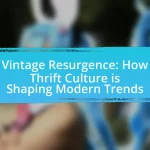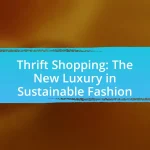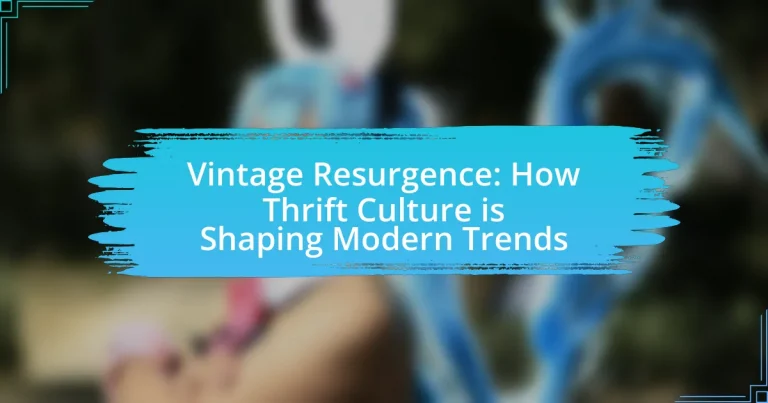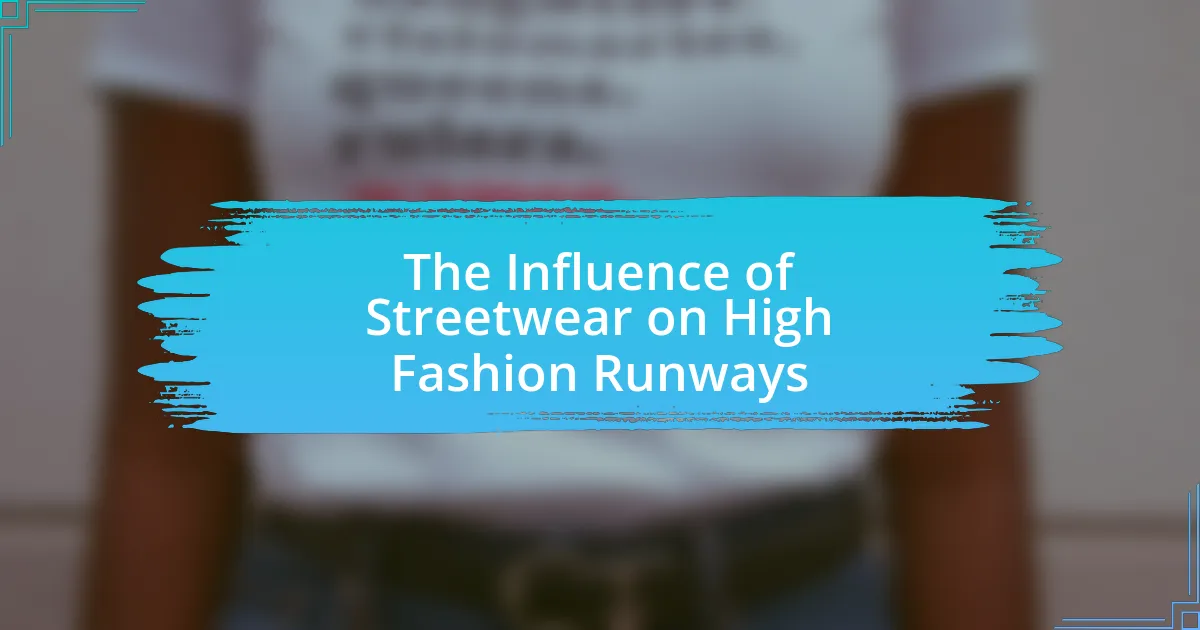Vintage Resurgence refers to the growing interest in vintage clothing and items, while Thrift Culture encompasses the practice of purchasing second-hand goods. This trend has emerged as a response to economic challenges and a heightened awareness of sustainability, with the second-hand market projected to reach $64 billion by 2024. The article explores the historical factors contributing to thrift culture, its evolution over the decades, and the impact of social media on vintage fashion. It also examines the characteristics of vintage items, consumer behavior shifts towards thrift shopping, and the strategies brands are employing to align with this trend. Additionally, it discusses the future implications of vintage resurgence and practical tips for consumers to embrace thrift culture sustainably.
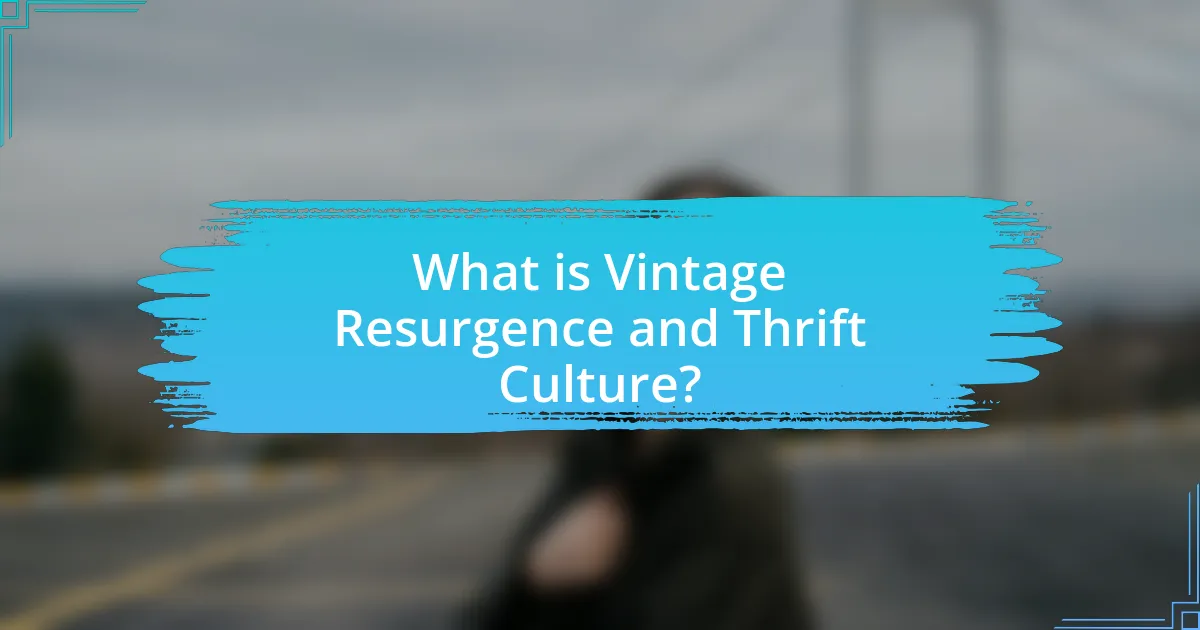
What is Vintage Resurgence and Thrift Culture?
Vintage Resurgence refers to the renewed interest in vintage clothing and items, while Thrift Culture encompasses the practice of purchasing second-hand goods, often from thrift stores or flea markets. This trend has gained momentum due to a growing awareness of sustainability, with consumers increasingly seeking unique, affordable fashion options that reduce waste. According to a 2021 report by ThredUp, the second-hand market is projected to reach $64 billion by 2024, highlighting the significant impact of thrift culture on modern consumer behavior.
How did thrift culture emerge in modern society?
Thrift culture emerged in modern society primarily as a response to economic challenges and a growing awareness of sustainability. The 2008 financial crisis significantly influenced consumer behavior, leading individuals to seek more affordable options and prioritize saving money. Additionally, the rise of environmental consciousness has prompted many to embrace second-hand shopping as a means to reduce waste and promote sustainable practices. According to a 2021 report by ThredUp, the second-hand market is projected to reach $64 billion by 2024, highlighting the increasing popularity of thrift culture among consumers.
What historical factors contributed to the rise of thrift culture?
The rise of thrift culture can be attributed to several historical factors, including economic downturns, wartime austerity, and the Great Depression. During the Great Depression of the 1930s, widespread unemployment and financial hardship led individuals to seek ways to save money, fostering a culture of thriftiness. Additionally, during World War II, rationing and scarcity of goods necessitated frugality, further embedding thrift practices into daily life. Post-war economic conditions also influenced consumer behavior, as people began to value sustainability and resourcefulness in response to previous hardships. These historical contexts established a foundation for thrift culture that continues to resonate today.
How has thrift culture evolved over the decades?
Thrift culture has evolved significantly over the decades, transitioning from a necessity during the Great Depression to a trendy lifestyle choice in contemporary society. In the 1930s, thrift stores emerged as vital resources for low-income families seeking affordable clothing and household items. By the 1980s and 1990s, thrift shopping gained popularity among young people as a means of expressing individuality and countering consumerism, with the rise of vintage fashion. In the 2000s, the advent of online platforms like eBay and Poshmark further democratized access to second-hand goods, while the recent emphasis on sustainability has propelled thrift culture into the mainstream, with brands and influencers promoting eco-friendly shopping practices. This shift is evidenced by a 2021 report from ThredUp, which projected that the second-hand market would reach $64 billion by 2024, highlighting the growing acceptance and integration of thrift culture in modern consumer behavior.
Why is vintage fashion gaining popularity today?
Vintage fashion is gaining popularity today due to a growing consumer preference for sustainability and individuality in clothing choices. This shift is driven by increased awareness of the environmental impact of fast fashion, with studies indicating that the fashion industry is responsible for 10% of global carbon emissions. Additionally, vintage clothing offers unique styles that allow individuals to express their personal identity, contrasting with the mass-produced items prevalent in contemporary retail. The rise of social media platforms has further amplified this trend, as influencers and fashion enthusiasts showcase vintage finds, making them more desirable and accessible to a wider audience.
What role does sustainability play in the vintage resurgence?
Sustainability is a driving force behind the vintage resurgence, as consumers increasingly prioritize eco-friendly practices in their purchasing decisions. The vintage market promotes the reuse of clothing and goods, significantly reducing waste and the environmental impact associated with fast fashion. According to a 2021 report by the Ellen MacArthur Foundation, the fashion industry is responsible for 10% of global carbon emissions, highlighting the urgent need for sustainable alternatives. By choosing vintage items, consumers contribute to a circular economy, extending the lifecycle of products and minimizing resource consumption. This shift not only reflects a growing awareness of environmental issues but also aligns with the values of younger generations who advocate for sustainable living.
How do social media and influencers impact vintage trends?
Social media and influencers significantly impact vintage trends by amplifying visibility and desirability through curated content and personal endorsements. Platforms like Instagram and TikTok allow influencers to showcase vintage clothing and accessories, creating a sense of authenticity and nostalgia that resonates with their followers. For instance, a study by the Pew Research Center found that 72% of teens use Instagram, where vintage fashion posts often receive high engagement, indicating a strong interest in retro styles. This visibility encourages consumers to explore thrift stores and vintage shops, contributing to the resurgence of vintage fashion in contemporary culture.
What are the key characteristics of vintage items?
Vintage items are characterized by their age, quality, and unique design, typically being at least 20 to 100 years old. These items often reflect the craftsmanship and aesthetic values of their time, making them desirable for collectors and enthusiasts. Additionally, vintage items frequently exhibit distinctive features such as materials, patterns, and styles that are no longer in production, which enhances their appeal. The historical context of these items, including their cultural significance and the era they represent, further solidifies their status as vintage.
How can consumers identify authentic vintage pieces?
Consumers can identify authentic vintage pieces by examining labels, materials, and construction techniques. Authentic vintage items often feature labels that indicate the brand and production era, with specific details like care instructions or country of origin that can date the piece. Additionally, vintage items are typically made from high-quality materials, such as natural fibers, and exhibit craftsmanship that reflects the manufacturing standards of their time, such as hand-stitching or unique patterns. For example, clothing from the 1960s may have specific stitching styles or fabric types that differ from modern mass-produced items. Furthermore, resources like vintage fashion guides or online databases can provide context and verification for specific brands and styles, helping consumers confirm authenticity.
What types of vintage items are most sought after?
The most sought-after vintage items include mid-century modern furniture, vintage clothing, vinyl records, and antique jewelry. Mid-century modern furniture, characterized by its clean lines and organic forms, has seen a resurgence in popularity due to its timeless aesthetic and functionality. Vintage clothing, particularly from the 1960s and 1970s, is highly valued for its unique styles and sustainable fashion appeal. Vinyl records have gained traction as collectors appreciate the analog sound quality and nostalgic experience they provide. Antique jewelry, especially pieces from the Victorian and Art Deco eras, is sought after for its craftsmanship and historical significance. These trends reflect a broader cultural shift towards valuing sustainability and individuality in consumer choices.
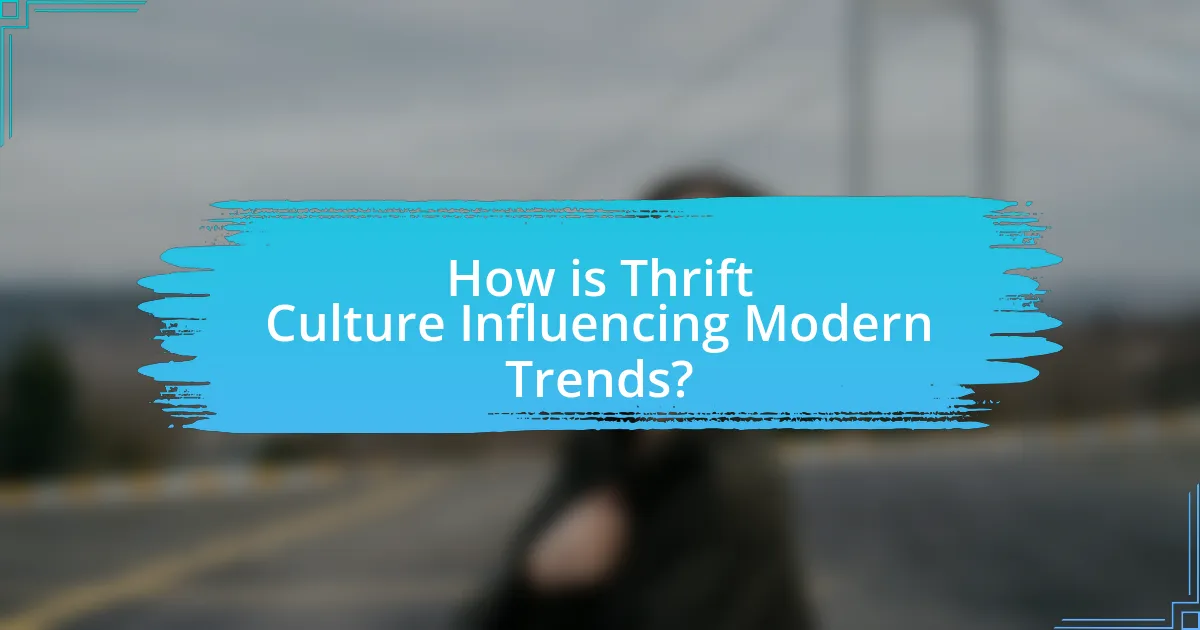
How is Thrift Culture Influencing Modern Trends?
Thrift culture is significantly influencing modern trends by promoting sustainability and individuality in fashion and consumer behavior. This cultural shift encourages consumers to seek second-hand clothing and vintage items, reducing waste and environmental impact. According to a 2021 report by ThredUp, the second-hand market is projected to reach $64 billion by 2024, indicating a growing preference for thrifted goods over fast fashion. Additionally, platforms like Depop and Poshmark have gained popularity, showcasing how thrift culture fosters unique personal styles while challenging conventional retail norms.
What impact does thrift culture have on consumer behavior?
Thrift culture significantly influences consumer behavior by promoting sustainable purchasing habits and encouraging a preference for second-hand goods. This cultural shift leads consumers to prioritize value and uniqueness over brand new items, often resulting in increased visits to thrift stores and online resale platforms. Research indicates that 70% of consumers are more likely to buy second-hand items due to environmental concerns, reflecting a growing awareness of sustainability in purchasing decisions. Additionally, thrift culture fosters creativity and individuality, as consumers seek distinctive pieces that reflect personal style rather than mass-produced items.
How are consumers shifting their purchasing habits towards thrift shopping?
Consumers are increasingly shifting their purchasing habits towards thrift shopping due to a growing awareness of sustainability and economic benefits. This trend is evidenced by a 2022 survey from ThredUp, which found that 70% of consumers are now more inclined to shop secondhand to reduce their environmental impact. Additionally, the rising cost of living has prompted many to seek affordable alternatives, with thrift stores offering significant savings compared to traditional retail. The combination of these factors has led to a notable increase in the popularity of thrift shopping, as consumers prioritize both budget-friendly options and eco-conscious choices.
What demographic groups are most engaged in thrift culture?
Young adults, particularly those aged 18 to 34, are the demographic group most engaged in thrift culture. This age group is driven by a combination of economic factors, sustainability concerns, and a desire for unique fashion. According to a 2021 survey by ThredUp, 70% of millennials and Gen Z consumers reported that they prefer shopping secondhand to reduce their environmental impact. Additionally, the rise of social media platforms has amplified thrift culture, with influencers showcasing thrifted finds, further attracting younger audiences.
How are brands responding to the thrift culture trend?
Brands are increasingly embracing the thrift culture trend by incorporating sustainable practices and offering vintage-inspired collections. Major retailers like Urban Outfitters and ASOS have launched second-hand sections to cater to the growing demand for thrifted items, reflecting a shift towards sustainability in fashion. Additionally, brands such as Patagonia promote repair and reuse initiatives, aligning their marketing strategies with the values of eco-conscious consumers. This response is validated by a 2022 report from ThredUp, which indicated that the second-hand market is projected to reach $82 billion by 2026, highlighting the significant consumer interest in thrift culture.
What strategies are brands using to incorporate vintage elements?
Brands are incorporating vintage elements through strategies such as upcycling, collaboration with vintage retailers, and the use of retro designs in their collections. Upcycling involves taking old materials or garments and transforming them into new products, which not only reduces waste but also appeals to consumers’ desire for unique items. Collaborations with vintage retailers allow brands to tap into established vintage markets, leveraging their expertise and customer base. Additionally, brands are increasingly adopting retro designs, drawing inspiration from past fashion trends, which resonates with consumers seeking nostalgia. This approach is supported by the growing popularity of thrift culture, as evidenced by a 2021 ThredUp report indicating that 33 million consumers in the U.S. shopped secondhand, reflecting a significant shift towards sustainable and vintage-inspired fashion choices.
How do collaborations between thrift stores and mainstream brands work?
Collaborations between thrift stores and mainstream brands typically involve the mainstream brand sourcing vintage or second-hand items from the thrift store to create a unique collection. This partnership allows the brand to tap into the growing consumer interest in sustainability and vintage fashion, while the thrift store benefits from increased visibility and sales. For example, in 2021, the collaboration between the thrift store Goodwill and the fashion brand Reformation showcased how mainstream brands can leverage thrifted items to appeal to eco-conscious consumers, resulting in a successful limited-edition collection that sold out quickly. This model not only promotes sustainable practices but also enhances the brand’s image by aligning with the values of a younger, environmentally aware demographic.

What are the Future Implications of Vintage Resurgence?
The future implications of vintage resurgence include a significant shift in consumer behavior towards sustainability and individuality in fashion. As consumers increasingly prioritize eco-friendly practices, the demand for vintage and thrifted items is expected to rise, reducing waste and promoting circular fashion. According to a report by ThredUp, the secondhand market is projected to reach $64 billion by 2024, indicating a strong trend towards sustainable consumption. This shift not only influences retail strategies but also encourages brands to adopt more sustainable practices, ultimately reshaping the fashion industry landscape.
How might thrift culture evolve in the coming years?
Thrift culture is likely to evolve towards increased digitalization and sustainability in the coming years. As online platforms for buying and selling second-hand goods gain popularity, consumers will have greater access to thrifted items, leading to a broader acceptance of pre-owned fashion. According to a report by ThredUp, the second-hand market is projected to reach $64 billion by 2024, indicating a significant shift in consumer behavior towards sustainable shopping practices. This evolution will be driven by a growing awareness of environmental issues and the desire for unique, vintage items, further solidifying thrift culture as a mainstream trend.
What technological advancements could influence thrift shopping?
Technological advancements such as mobile apps, artificial intelligence, and online marketplaces significantly influence thrift shopping. Mobile apps enable users to easily browse and purchase second-hand items, enhancing accessibility and convenience. Artificial intelligence can personalize shopping experiences by recommending items based on user preferences and past purchases, thereby increasing customer engagement. Online marketplaces, like Poshmark and Depop, provide platforms for individuals to sell thrifted items, expanding the reach of thrift shopping beyond local stores. According to a report by ThredUp, the online resale market is projected to reach $64 billion by 2024, highlighting the growing impact of technology on thrift shopping.
How will changing consumer values shape the future of vintage fashion?
Changing consumer values will significantly shape the future of vintage fashion by prioritizing sustainability and individuality. As consumers increasingly seek eco-friendly options, the demand for vintage clothing, which promotes recycling and reduces waste, will rise. According to a 2021 survey by ThredUp, 70% of consumers are more likely to buy secondhand items due to environmental concerns. This shift towards valuing sustainability will drive the growth of vintage fashion markets, as consumers view these garments as not only unique but also responsible choices. Additionally, the desire for personal expression will lead to a greater appreciation for vintage styles, as individuals seek to differentiate themselves from mass-produced fashion.
What practical tips can consumers follow to embrace thrift culture?
Consumers can embrace thrift culture by regularly visiting thrift stores, participating in clothing swaps, and learning basic repair skills for clothing and household items. Thrift stores often offer unique, vintage items at significantly lower prices compared to retail, promoting sustainability and creativity in personal style. Clothing swaps allow individuals to refresh their wardrobes without spending money, fostering community and reducing waste. Additionally, acquiring repair skills can extend the life of items, aligning with the thrift culture’s emphasis on resourcefulness. According to a 2021 survey by ThredUp, 70% of consumers are interested in shopping secondhand to reduce their environmental impact, highlighting the growing trend towards thrift culture.
How can individuals effectively curate their vintage collections?
Individuals can effectively curate their vintage collections by focusing on specific themes, researching the history and value of items, and regularly assessing their collection for quality and relevance. Establishing a theme, such as a particular era or style, helps in selecting items that complement each other, enhancing the overall aesthetic. Researching the history and market value of vintage items allows collectors to make informed decisions, ensuring they invest in pieces that are not only meaningful but also potentially valuable. Regularly assessing the collection helps maintain its quality and relevance, allowing individuals to refine their focus and make space for new acquisitions. This approach is supported by the growing interest in vintage items, as evidenced by the 2021 ThredUp Resale Report, which noted that the secondhand market is projected to reach $64 billion by 2024, highlighting the increasing value and demand for curated vintage collections.
What are the best practices for sustainable thrift shopping?
The best practices for sustainable thrift shopping include selecting high-quality items, prioritizing local thrift stores, and donating unwanted clothing back to thrift shops. High-quality items tend to last longer, reducing the need for frequent replacements and minimizing waste. Shopping at local thrift stores supports community economies and reduces carbon footprints associated with transportation. Donating unwanted clothing ensures that items are reused, extending their lifecycle and promoting a circular economy. According to the Environmental Protection Agency, reusing clothing can significantly reduce landfill waste, highlighting the importance of these practices in sustainable thrift shopping.
